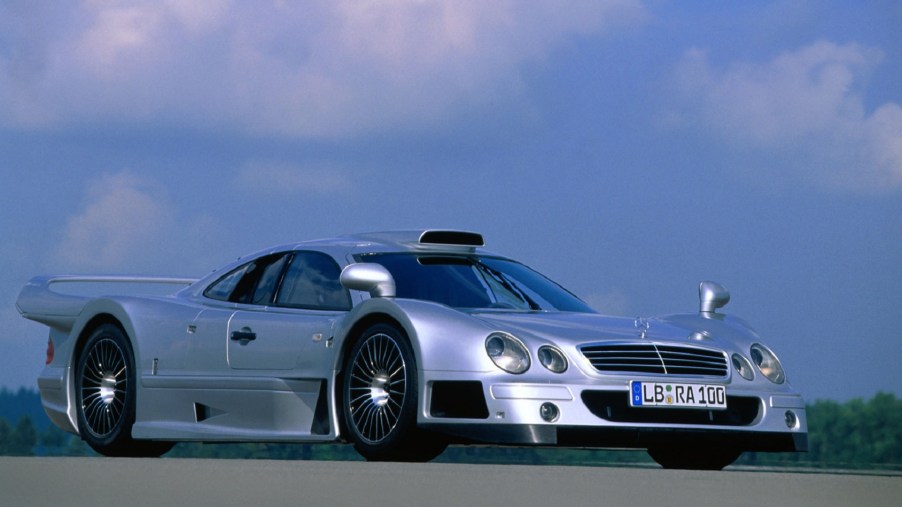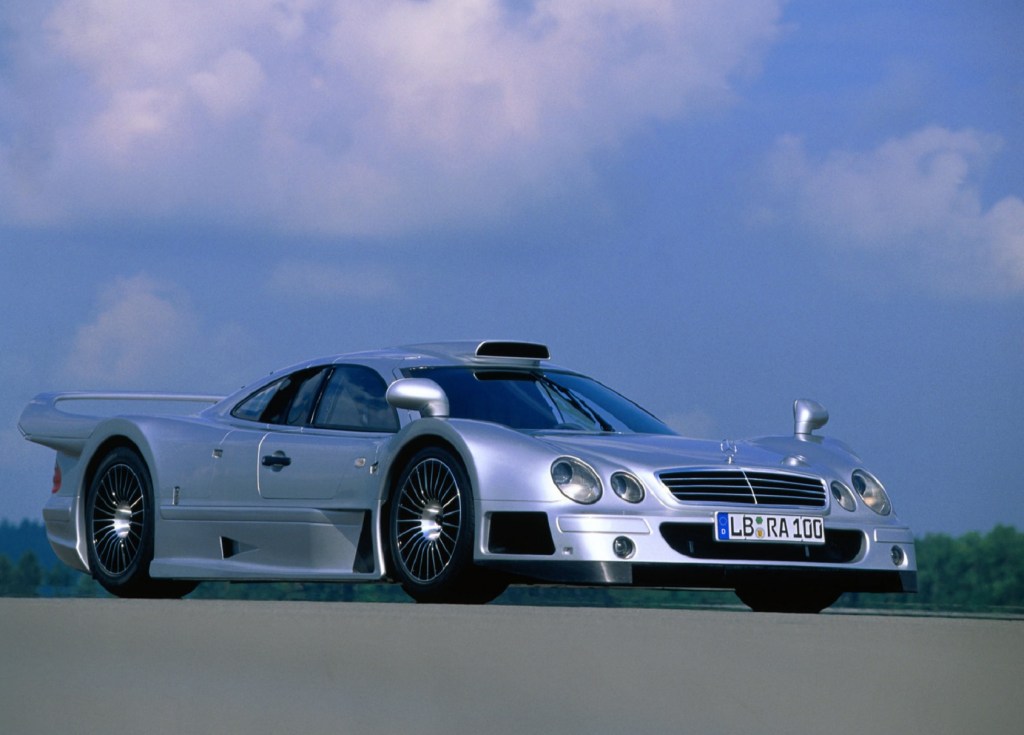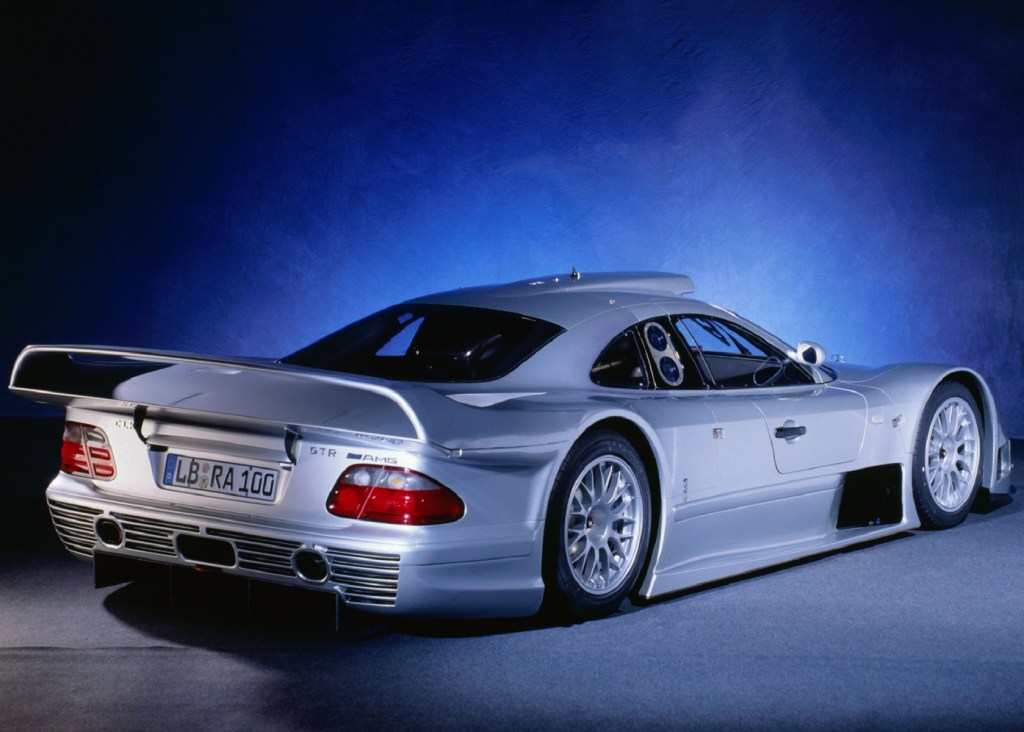
The Mercedes CLK GTR Story Starts With a Modified McLaren F1
AMG is more than just the road performance arm of Mercedes-Benz. The tuner/division’s history starts with the race-ready ‘Red Pig’ Mercedes sedan. And ever since Mercedes purchased it, AMG has been the German automaker’s motorsports division. That means it was also in charge of creating one of the most iconic homologation supercars of the ‘90s: the Mercedes CLK GTR. Doing so, though, required the help of another supercar legend: the McLaren F1.
The Mercedes CLK GTR was built to beat the McLaren F1 using a McLaren F1

On a superficial level, the Mercedes CLK GTR and the McLaren F1 follow a similar formula. Both are rear-wheel-drive supercars with mid-mounted V12 engines, carbon-fiber chassis, and carbon-fiber bodywork. Though in the CLK GTR’s case, the chassis also has some Kevlar, Car and Driver notes.
They both also owe their existence to racing; quite literally, in the CLK GTR’s case. Yet, the Mercedes CLK GTR also wouldn’t exist without the F1.

Though he drew on his Formula 1 experience, Gordon Murray didn’t design the F1 for racing, Road & Track explains. It was only after customers asked for a racing version that McLaren created the F1 GTR. But despite its somewhat casual development, the F1 GTR was almost immediately a dominating force on the racetrack. And in 1997, it started competing in the newly-formed FIA GT class.
This is where Mercedes-Benz gets involved. After the DTM racing series collapsed in 1996, the German automaker didn’t have a motorsports outlet, Hagerty reports. So, when the FIA GT class was announced, it jumped at the opportunity. However, that left Mercedes and AMG with a fairly short time frame to develop the CLK GTR. In total, the team designed, built, and tested its race car in 128 days, or just over four months, R&T reports.

Luckily, AMG had a helpful time-saving tool at its disposal during Mercedes CLK GTR development: a McLaren F1 GTR. Mercedes bought and modified an original F1 GTR to use as a development mule. And here, ‘modified’ means ‘fitted custom bodywork and an AMG engine to.’
But even with the chopped-up F1 speeding things up, AMG only just finished in time. The CLK GTR wasn’t officially homologated until six days before its first race, R&T reports.
To quote Carfection, the Mercedes CLK GTR is “an absolute animal of a car”
It may have arguably been a rush job, but the Mercedes CLK GTR was a successful race car. While it never won at Le Mans, it won six of the 11 1997 races, earning Mercedes the Driver’s and Constructor’s Championships, Autoweek reports. And as Carfection host Henry Catchpole explains in the video below, its performance still intimidates.
The Mercedes CLK GTR uses a V12 originally designed for the W140 S-Class and R129 SL. In the latter two cars, it’s a 6.0-liter engine. However, the CLK GTR has a 6.9-liter V12 rated at 612 hp and 568 lb-ft, The Drive reports. A few ‘Super Sport’ examples had an even larger 7.3-liter V12 with over 654 hp, Automobile reports. And unlike the McLaren F1, the CLK GTR doesn’t have a traditional manual transmission. Instead, it has a paddle-shifted six-speed sequential transmission with a foot clutch. With it, the Mercedes goes 0-60 mph in 3.8 seconds, Autoweek reports.
The Mercedes CLK GTR isn’t as practical as the McLaren F1. It only has two seats, no real trunk, and the interior is “rather cramped,” R&T reports. Catchpole claims “it might just be the most awkward car I’ve ever got [sic] into.” But it does have leather seats, A/C, a radio, and interior trim from Mercedes of the era. Plus, the wide door sills double as cargo areas, and the steering wheel is removable. So, while it’s more ‘extreme’ than the F1’s interior, it’s arguably more ‘normal.’
On the move, though, the Mercedes CLK GTR “feels really special,” Carfection says. It feels shorter than it is going around corners, with plenty of grip and communicative steering. It weighs more than the F1, but the CLK GTR’s engine makes more torque and a deeper noise. And the sequential transmission is “much, much better than…expected,” Carfection reports.
It’s an exceedingly rare supercar that’s “more race car than street car,” Road & Track says
The average enthusiast has a higher chance of spotting a McLaren F1 ‘in the wild’ than a Mercedes CLK GTR. For one, at its release it was the most expensive production car in the world, R&T says. And secondly, Mercedes only made enough to satisfy the homologation requirements. So, while there were 107 F1s, there are only 25 CLK GTRs.
However, despite its rarity, the CLK GTR is less expensive than the F1. True, one example sold at a 2018 RM Sotheby’s auction for $4,515,000. But F1s regularly trade at 2-3 times that much, if not more.
Follow more updates from MotorBiscuit on our Facebook page.


